Messi's meaning for Colorado
The greatest soccer player that ever lived is coming to MLS. It will have a huge impact - and some of those impacts will reach all the way to Commerce City.
Yesterday, after many months of ‘will he or won’t he’ suspense, it was confirmed that indeed, he will. Lionel Messi will play in MLS this season.
This will have many implications for Colorado soccer and American soccer as a whole. I thought I’d have a go at some preliminary thoughts.1
1. Welcome to MLS 4.0
Up till now, MLS has had three phases.
First, from 1996-2007, it was MLS 1.0. The league was trying to find its footing and establish itself safely. They even tinkered with “fun!” alternative American soccer rules, like doing away with ties, and having run-up shootouts. The first five years of MLS were financially shaky. But nevertheless, the league was persistent. And then in 2001 came the contraction of Tampa Bay Mutiny and Miami Fusion, and an overall sense that the league was perhaps doomed. It survived those days, and things stabilized with expansion in 2004 and 2005 (RSL, Houston, and Toronto.) But MLS was still a novelty league with limited appeal, poor TV reach, and unknown potential.
Then came David Beckham.
Global megastar, husband to Posh Spice, perhaps the best deadball artist in the history of football; the LA Galaxy’s acquisition of David Beckham changed the league forever and ushered in the so-called ‘MLS 2.0’ era. You might also just call it ‘The Beckham Era’. The very possibility that a player of his stature would be willing to play football with Alan Gordon and Chris Klein and Sean Franklin meant that the league had a measure of respect - and global attention - it had never had before. Crowds followed. TV contracts followed. Money followed.
More global stars followed, like Thierry Henry, David Villa, Frank Lampard, Steven Gerrard, Kaká, and Andrea Pirlo. They came because Beckham’s arrival required an entirely new salary structure for superstar players. The new Designated Player rule meant that star players could finally come to MLS and make real money. And there were more expansion teams, as more owners wanted to get in on the rising star that was MLS. Seattle, Philadelphia, Portland, Vancouver, and Montreal joined the league. Teams still chose American nicknames for their clubs like ‘Sounders’ and ‘Impact’. MLS 2.0 lasted from Beckham’s first year in 2007 till roughly 2014. Beckham himself returned to Europe in 2013, joining PSG.
The third phase of MLS, ‘MLS 3.0’, is about big expansion fees, soccer specific stadiums, and an overall maturation of the league. No more goofy MLS 1.0 team nicknames like ‘Galaxy’ or ‘Metrostars’; every new team wanted to be ‘<insert city> United’ or ‘<insert city> FC.’ It began with Orlando and NYCFC (Ok, so if your city is big enough, you don’t have to have a soccer specific stadium) and continued with Minnesota, Atlanta, LAFC, Nashville, Austin, Miami, and Cincinnati. Some big stars came in this era for sure, like Zlatan Ibrahimovic2 and Carlos Vela. Other teams actually *made* players stars and sold them on, like Miguel Almirón and Ricardo Pepi and Cyle Larin.
With the coming of Messi to to Inter Miami, we enter MLS 4.0. The league will suddenly have global interest like it never had before. Yes, Messi is 35 years old. But he’s still pretty freaking good, as his dominant performance in the 2022 World Cup demonstrated. And with an Apple TV deal that allows for global access to MLS games from nearly any device, the barriers are very low to watch Messi.3 By comparison, there’s probably a way to watch Cristiano Ronaldo in the Saudi league, but I don’t know how, and I have no interest in watching him or the Saudi league anyway.
Messi will expose tens of millions of people to MLS who had never considered it. It suddenly makes the league much more compelling to the millions in our hemisphere that preferred Liga MX to MLS. And even if he only plays two or three years here, many of those fans will stay engaged in MLS after Messi has retired - especially if he buys into a team with his rumored special ‘Beckham expansion discount’.
This is a game changer for the league in money, and scale, and profile. I have long believed in the product MLS is selling. For every eurosnob you meet at a soccer pub, for every ‘soccer’s boring!’ average American sports fan, the response I would give has always been the same: watch a game. Watch a good player; watch a stunning moment; fall in love with a team; sit in the Supporters section. Buy a ticket. Watch a game, and you’ll become a believer. Most of them haven’t. Now they will. Hundreds of thousands will watch Messi in an MLS match in person. Tens of millions; hundreds of millions; will watch on TV. They will buy kits. They will keep watching. After Jordan retired, the NBA was still a global phenomenon. After Messi retires, folks will still keep their eyes on MLS.
2. Live in Colorado? Wanna see Messi in 2023 or 2024? Buy a plane ticket.
If you live in the state of Colorado and are hoping to see Messi at DSGP or Empower Field at Mile High4, think again. The Rapids don’t play Inter Miami this year. Odds that we play them in Colorado next year? Pretty slim. And even if Inter Miami do play in Colorado, many are skeptical that Messi would be pressed into service at high altitude.
MLS teams currently play home and away against all the teams in their own conference; thus Colorado plays 27 matches against teams like San Jose, Salt Lake, and Austin (we play three games against RSL). The remaining seven games go to Eastern Conference teams. This will likely be the same in 2024.
Inter Miami, as it happens, has never met the Colorado Rapids, either in Commerce City or in Fort Lauderdale. Maybe that means they will finally meet next year. But still, IF Miami end up on our schedule, odds are still only 50/50 that the game will be in the Denver metro area.
Even if Inter Miami do play the Rapids in 2024, and even if the game is in Colorado, there’s no way they’d hold the game at Dick’s Sporting Goods Park. The Dick only holds 18,000 people, while Messi would easily draw 75,000. That means the game would have to take place at Empower/Mile High. But Kroenke Sports Entertainment doesn’t own the Broncos or Mile High, so any gate revenue would have to be split. That seems iffy – KSE brought Arsenal to town in 2019, and although Arsenal could easily draw 50,000 at Mile High, KSE kept the cash and played at quaint little DSGP. I think this whole problem will be in consideration when MLS makes the schedule for next year: because the Kroenkes don’t seem to have a clear way to showcase Messi in the Mile High City, I don’t think MLS Commissioner Dan Garber will give them the satisfaction.5
3. Suddenly, Colorado are Eibar
You would be forgiven if you admit you have never heard of the Spanish La Liga team Eibar. In 2014, the small Basque-country team won promotion to La Liga, and with it the right to play Messi’s Barcelona and Cristiano Ronaldo’s Real Madrid each season. Their home ground, Ipurua Municipal Stadium, was built in 1947. According to wikipedia, it was improved and expanded in 1998 to hold a whopping crowd of 2,800. This was the stadium Eibar had the year they were to host Lionel Messi.
So, of course, they added seats to bring capacity up to 7,300. Which is still an incredibly small capacity for a top flight club in one of Europe’s big four leagues. But this is how it is. It seems insane! How can Spain have a ground that small and players so spectacular? Well, Spain is a small country. If you want to see Messi play, there are 20 cities you can drive to see him. You can get from Eibar to Madrid in 4 hours. You can get from Eibar to Bilbao in 45 minutes. You have easily drivable options other than Eibar for seeing Messi. Anyhow, Eibar were relegated back to the Secunda Division in 2021. They are currently in the La Liga 2 playoffs; a win would promote them back to the top division. Really, though, the takeaway observation is that Eibar isn’t a suitable venue to witness top division soccer in Spain, and if they get promoted again and stick around, they really need to up their game.
Colorado Rapids have a lovely little ground called Dick’s Sporting Goods Park, located in Commerce City, CO. Built in 2007, it was a great success for the Rapids at the time, because it got them out of cavernous Mile High Stadium. Additionally, by locating itself on a huge tract of land and centering the stadium amidst 25 soccer pitches intended for youth teams and summer tournaments, DSGP stood like an aspirational beacon for youth and academy players in Colorado. Practice hard enough; train well enough; and someday you will play inside that stadium. Dick’s was also a Soccer Specific Stadium at a time when this was the beginning of that trend in MLS – the Rapids were ahead of San Jose Earthquakes, DC United, Houston Dynamo, and Sporting Kansas City in building their SSS. They are also ahead of New England Revolution, who still play on a throwball pitch.6
But 2007 was a long time ago. And DSGP has not aged gracefully.
Friend of HTHL Jody Robins added “Also the roof is basically useless.”7
Friend of HTHL Eric Stinson added “Seats are old and broken. Video board looks like an 80s relic. DSGP has aged worse than a bad bus terminal. Good options so bad, might as well get food at Northfield. Garber cares less than Kroenke does and that’s saying something.”
In other words, as I mentioned in points 1 and 2, MLS is about to gain a huge amount of global attention. And the Colorado Rapids are not ready for their close up, Mr. DeMille.
DSGP needed upgrades and investment even before Messi became a player in the league. But now that it seems possible that he will either A) bypass Commerce City because our quaint little pitch isn’t worthy of his divine presence, or B) actually come to Commerce City, and folks will shell out ungodly sums of cash to sit in broken uncovered seats, eat stale nachos, and watch a video screen that’s more busted than your uncle’s 1974 Chrysler Le Baron.
In a league where expansion teams go for $500 million; in a league where Carlos Vela and Gareth Bale played *for the same team*; in a league with celebrity investors like Drew Carey, Will Farrell, and Matthew McConaughey; in a league where the new stadiums in Atlanta, Austin, LA, Cincinnati and Columbus have ample amenities; the Rapids are being left behind. Messi only shines a light on that in a bigger way.
Kroenke Sports Entertainment has frequently been chastised for underinvesting in the Rapids. The league seems to have failed to this point to push KSE into action. Will the addition of Messi be the straw that breaks Stanley and Josh’s backs?
Apple is the biggest winner from this deal. Whatever they spend on their end to get Messi (reported to be a percentage of new Apple TV+ subscriptions) it’ll be worth it. He’s going to quintuple their MLS package signups, and many of those subscribers will stay subscribed for years beyond Messi’s retirement.
I didn’t remember this name, and only just now googled what the ‘Empower’ company does. Ucch, so stupid.
“But Rabbi,” you say, “the league must make the East-West matchups and locations, random, right?” I think normally they would. But I don’t think anything about a season with Lionel Messi will be normal. If Leo says ‘I want to play away in LA, Seattle, Portland and San Francisco’, that’s where he playing.
This will never cease to be a source of shame for American soccer, and is as unacceptable, or even worse, than NYCFC playing in a baseball stadium. To their credit, NYCFC are building a new stadium.
If you are in the West stand on a sweltering summer evening, you get a respite from the sun. But if it’s raining or snowing, or you’re seated in the other 10,000 seats, yeah, the roof is useless.

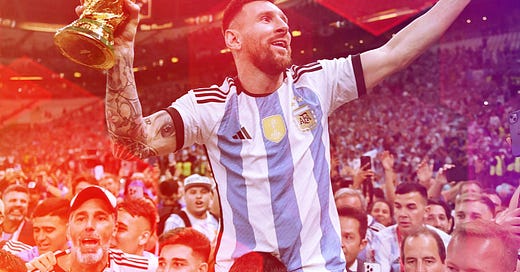



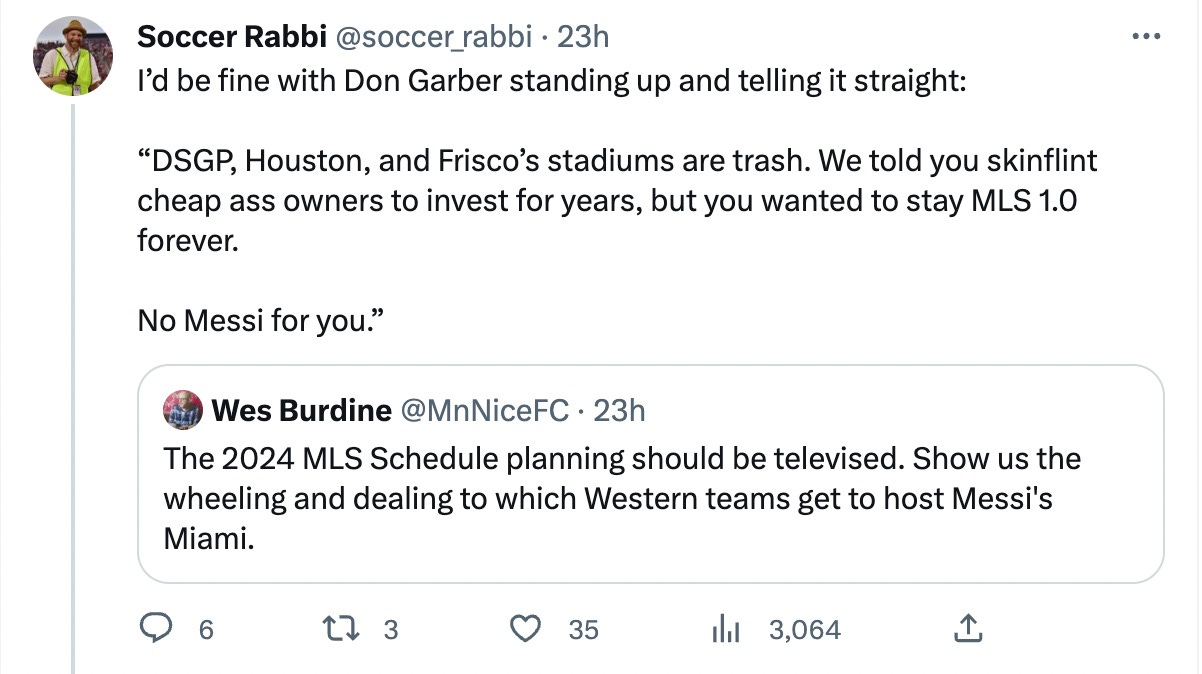
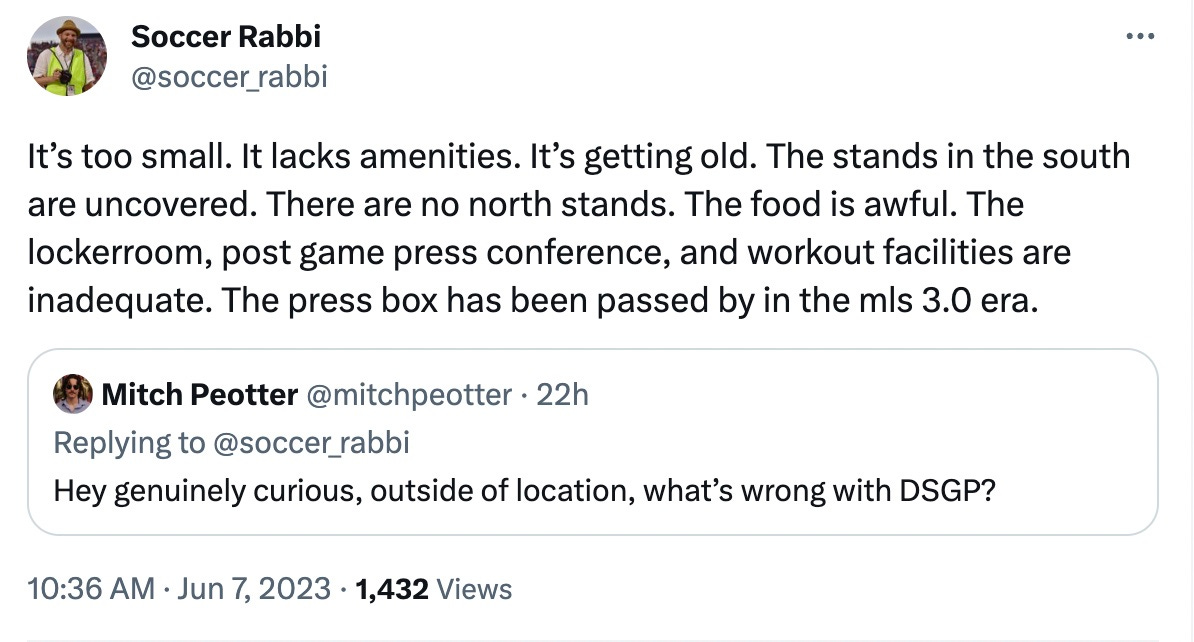
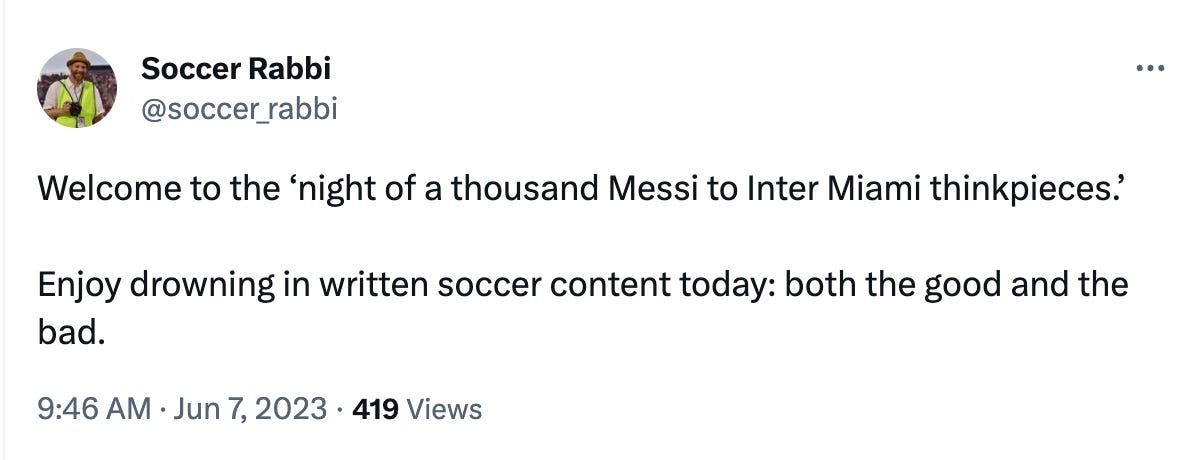
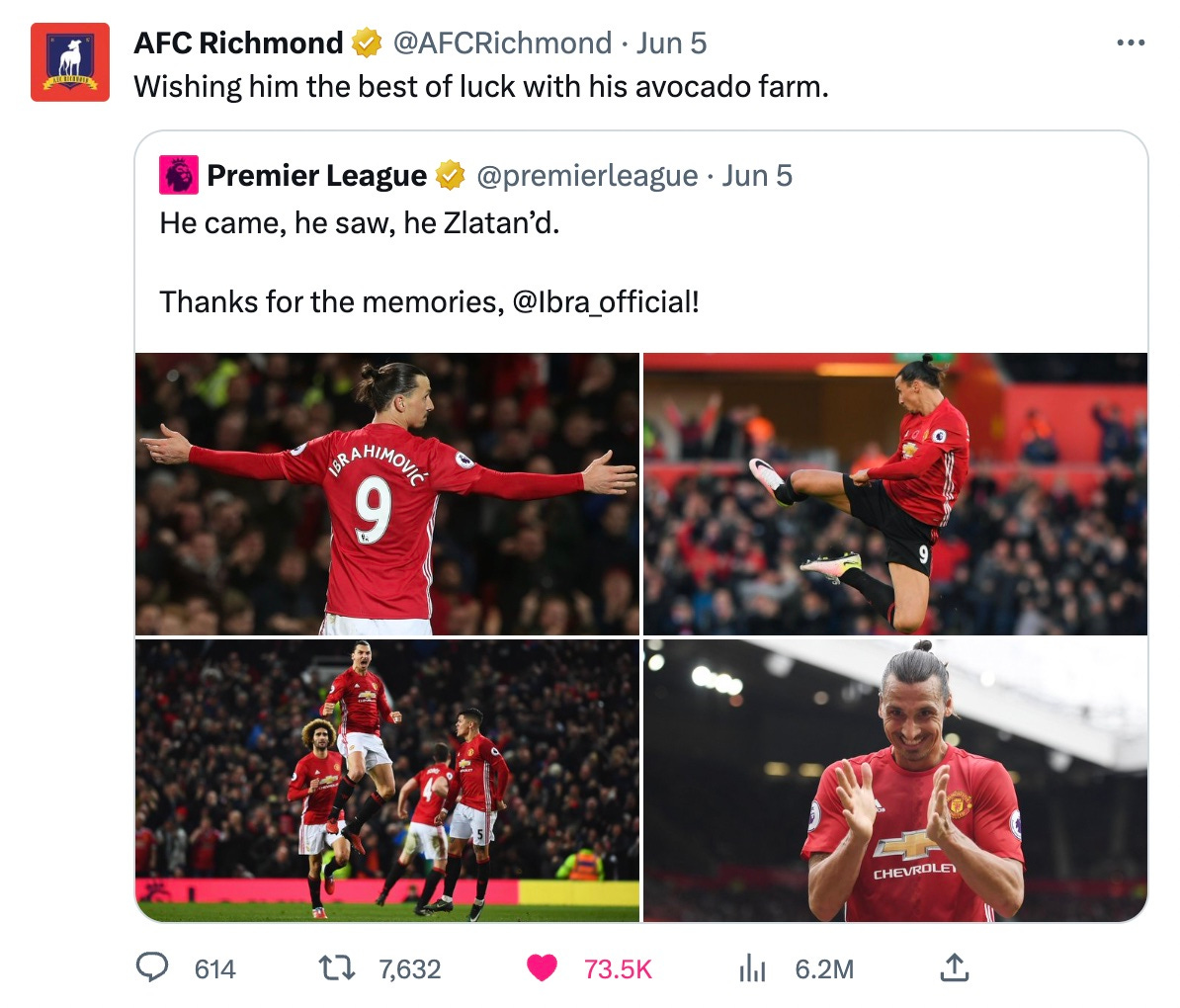
hey there! wanted to share the article, there are some typos, "Dan" instead of Don Garber, Secunda División should be Segunda División. A few others, but those I remember :)
The Dick is ok, I like that you see the field from the concourse. And the roof is for a place that used to get little rain and a team that plays in the evenings.